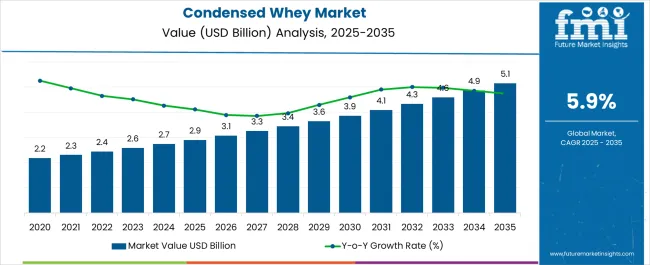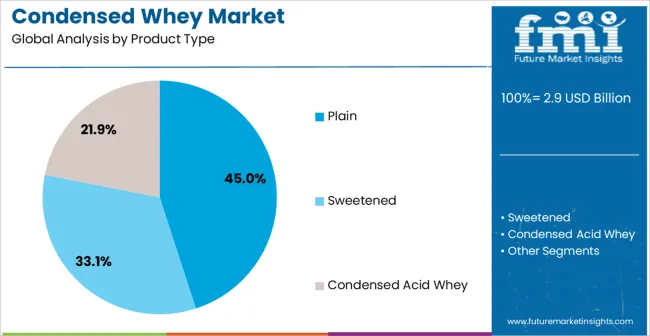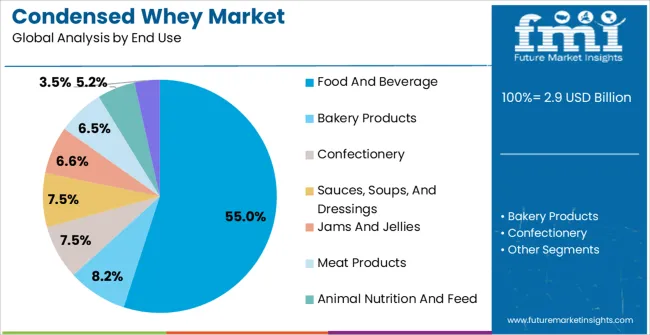The Condensed Whey Market is estimated to be valued at USD 2.9 billion in 2025 and is projected to reach USD 5.1 billion by 2035, registering a compound annual growth rate (CAGR) of 5.9% over the forecast period.

| Metric | Value |
|---|---|
| Condensed Whey Market Estimated Value in (2025 E) | USD 2.9 billion |
| Condensed Whey Market Forecast Value in (2035 F) | USD 5.1 billion |
| Forecast CAGR (2025 to 2035) | 5.9% |
The Condensed Whey market is experiencing steady growth, supported by its critical role as a high-protein ingredient across diverse applications. The current market scenario is characterized by increasing demand from food and beverage manufacturers, who are leveraging condensed whey for its nutritional content, functional properties, and cost efficiency.
Growth has been further enabled by rising consumer awareness of protein-rich diets, health and fitness trends, and the growing demand for dairy-derived ingredients in processed foods. Technological improvements in whey processing and concentration methods are enhancing product quality and shelf stability, allowing wider adoption across regions.
Additionally, the market outlook is positively shaped by increasing investments in dairy infrastructure and fortified food formulations, which provide avenues for product innovation As health-conscious consumption patterns continue to expand globally, condensed whey is anticipated to remain a key ingredient for both established food brands and emerging manufacturers, supporting consistent market expansion in the foreseeable future.
The condensed whey market is segmented by product type, end use, and geographic regions. By product type, condensed whey market is divided into Plain, Sweetened, and Condensed Acid Whey. In terms of end use, condensed whey market is classified into Food And Beverage, Bakery Products, Confectionery, Sauces, Soups, And Dressings, Jams And Jellies, Meat Products, Animal Nutrition And Feed, and Powdered Whey. Regionally, the condensed whey industry is classified into North America, Latin America, Western Europe, Eastern Europe, Balkan & Baltic Countries, Russia & Belarus, Central Asia, East Asia, South Asia & Pacific, and the Middle East & Africa.

The plain product type is projected to hold 45.0% of the Condensed Whey market revenue in 2025, making it the leading product variant. This dominance is attributed to its versatility, high protein content, and suitability for blending into a wide range of formulations without altering taste or texture. The growth of this segment has been reinforced by the demand for clean-label and minimally processed ingredients, which are increasingly preferred by food and beverage manufacturers.
Plain condensed whey is compatible with bakery, dairy, and protein-enriched applications, allowing it to serve as a functional ingredient that improves emulsification, moisture retention, and nutritional value. The market expansion is further supported by advances in whey concentration technology that enhance solubility and shelf life.
Additionally, manufacturers have favored plain condensed whey for its ability to provide consistent quality and performance, which reduces formulation complexity and ensures predictable results in end-use products These factors have collectively driven the plain product type to lead the condensed whey market in revenue share.

The food and beverage end-use segment is anticipated to capture 55.0% of the total Condensed Whey market revenue in 2025, establishing it as the dominant application sector. This prominence is being driven by the increasing incorporation of condensed whey in bakery items, beverages, confectionery, and dairy-based products for its high protein content, functional properties, and cost efficiency.
The segment has benefited from growing consumer preference for protein-fortified products, clean-label ingredients, and fortified nutrition options in both developed and emerging markets. Condensed whey allows manufacturers to enhance texture, improve moisture retention, and boost nutritional value without compromising taste, which has facilitated its widespread adoption.
The ongoing trend toward health-conscious diets, along with the rising popularity of sports nutrition and ready-to-drink protein beverages, has further reinforced demand As manufacturers continue to innovate and incorporate protein-rich ingredients in product development, the food and beverage sector is expected to sustain its market leadership in condensed whey consumption, driven by both functionality and growing consumer awareness.
The condensed whey market is estimated to be valued at USD 2.9 billion in 2025 and is projected to reach USD 5.1 billion by 2035, registering a CAGR of 5.9% over the forecast period. The condensed whey market is forecast to add an absolute dollar opportunity of USD 2.2 billion by 2035. This reflects a 1.76× increase over the forecast period. Growth in the condensed whey market is expected to be driven by increasing demand for protein-rich dairy ingredients across functional foods, beverages, and animal nutrition, as well as by rising interest in sustainable dairy by-product utilization.
By 2035, the condensed whey market is likely to reach approximately USD 4.15 billion, accounting for USD 1.25 billion in incremental value during the first half of the decade. The remaining USD 0.95 billion is projected to be added between 2035 and 2035, indicating a moderately back-loaded growth trajectory and supported by increasing global industrial utilization and health-focused product innovations.
Strategic advancements in the condensed whey market are being made by leading companies through investment in filtration systems, production line automation, and new product development. Market competitiveness is being enhanced through sustainable sourcing models, facility expansions, and increased R&D focused on application-specific formulations. Growth has been anchored in regulatory compliance, cost efficiency, nutritional value, and compatibility with emerging clean-label trends.
The condensed whey market is considered a subset of broader industry verticals such as the whey protein market and dairy ingredients market. Within the global Whey Protein Market, condensed whey is estimated to account for roughly 12% of the total segment value in 2025. Meanwhile, in the Dairy Ingredients Market, the condensed whey market is projected to hold nearly 6% of the global share. These figures reflect the niche but expanding application base of condensed whey across food processing, clinical nutrition, and industrial feed chains, where its protein concentration and functional utility continue to provide a comparative advantage.
Growth in the condensed whey market is being supported by increasing awareness of protein-based nutrition, evolving clean-label formulations, and broader application in fortified food and beverage categories. Demand is being further elevated by its use in animal feed, sports nutrition, and bakery. Technological advancements in condensation and spray drying are enabling cost-efficient production and improved shelf life. Demand for responsibly sourced dairy by-products is also accelerating market penetration. Innovations in lactose management, functional blends, and energy-efficient processing systems are being implemented across facilities. Rising regulatory approvals and strategic expansions in Asia-Pacific are also expected to contribute to long-term performance.

| Country | CAGR |
|---|---|
| China | 8.0% |
| India | 7.4% |
| Germany | 6.8% |
| Brazil | 6.2% |
| USA | 5.6% |
| UK | 5.0% |
| Japan | 4.4% |
The Condensed Whey Market is expected to register a CAGR of 5.9% during the forecast period, exhibiting varied country level momentum. China leads with the highest CAGR of 8.0%, followed by India at 7.4%. Developed markets such as Germany, France, and the UK continue to expand steadily, while the USA is likely to grow at consistent rates. Japan posts the lowest CAGR at 4.4%, yet still underscores a broadly positive trajectory for the global Condensed Whey Market. In 2024, Germany held a dominant revenue in the Western Europe market and is expected to grow with a CAGR of 6.8%. The USA Condensed Whey Market is estimated to be valued at USD 1.0 billion in 2025 and is anticipated to reach a valuation of USD 1.0 billion by 2035. Sales are projected to rise at a CAGR of 0.0% over the forecast period between 2025 and 2035. While Japan and South Korea markets are estimated to be valued at USD 148.2 million and USD 74.3 million respectively in 2025.

| Item | Value |
|---|---|
| Quantitative Units | USD 2.9 Billion |
| Product Type | Plain, Sweetened, and Condensed Acid Whey |
| End Use | Food And Beverage, Bakery Products, Confectionery, Sauces, Soups, And Dressings, Jams And Jellies, Meat Products, Animal Nutrition And Feed, and Powdered Whey |
| Regions Covered | North America, Europe, Asia-Pacific, Latin America, Middle East & Africa |
| Country Covered | United States, Canada, Germany, France, United Kingdom, China, Japan, India, Brazil, South Africa |
| Key Companies Profiled | Dairy Farmers of America, Agri-Mark, Inc., Foremost Farms USA, Associated Milk Producers Inc., and Leprino Foods Company |
The global condensed whey market is estimated to be valued at USD 2.9 billion in 2025.
The market size for the condensed whey market is projected to reach USD 5.1 billion by 2035.
The condensed whey market is expected to grow at a 5.9% CAGR between 2025 and 2035.
The key product types in condensed whey market are plain, sweetened and condensed acid whey.
In terms of end use, food and beverage segment to command 55.0% share in the condensed whey market in 2025.






Our Research Products

The "Full Research Suite" delivers actionable market intel, deep dives on markets or technologies, so clients act faster, cut risk, and unlock growth.

The Leaderboard benchmarks and ranks top vendors, classifying them as Established Leaders, Leading Challengers, or Disruptors & Challengers.

Locates where complements amplify value and substitutes erode it, forecasting net impact by horizon

We deliver granular, decision-grade intel: market sizing, 5-year forecasts, pricing, adoption, usage, revenue, and operational KPIs—plus competitor tracking, regulation, and value chains—across 60 countries broadly.

Spot the shifts before they hit your P&L. We track inflection points, adoption curves, pricing moves, and ecosystem plays to show where demand is heading, why it is changing, and what to do next across high-growth markets and disruptive tech

Real-time reads of user behavior. We track shifting priorities, perceptions of today’s and next-gen services, and provider experience, then pace how fast tech moves from trial to adoption, blending buyer, consumer, and channel inputs with social signals (#WhySwitch, #UX).

Partner with our analyst team to build a custom report designed around your business priorities. From analysing market trends to assessing competitors or crafting bespoke datasets, we tailor insights to your needs.
Supplier Intelligence
Discovery & Profiling
Capacity & Footprint
Performance & Risk
Compliance & Governance
Commercial Readiness
Who Supplies Whom
Scorecards & Shortlists
Playbooks & Docs
Category Intelligence
Definition & Scope
Demand & Use Cases
Cost Drivers
Market Structure
Supply Chain Map
Trade & Policy
Operating Norms
Deliverables
Buyer Intelligence
Account Basics
Spend & Scope
Procurement Model
Vendor Requirements
Terms & Policies
Entry Strategy
Pain Points & Triggers
Outputs
Pricing Analysis
Benchmarks
Trends
Should-Cost
Indexation
Landed Cost
Commercial Terms
Deliverables
Brand Analysis
Positioning & Value Prop
Share & Presence
Customer Evidence
Go-to-Market
Digital & Reputation
Compliance & Trust
KPIs & Gaps
Outputs
Full Research Suite comprises of:
Market outlook & trends analysis
Interviews & case studies
Strategic recommendations
Vendor profiles & capabilities analysis
5-year forecasts
8 regions and 60+ country-level data splits
Market segment data splits
12 months of continuous data updates
DELIVERED AS:
PDF EXCEL ONLINE
Whey Protein Market Size and Share Forecast Outlook 2025 to 2035
Whey Protein Ingredients Market Size and Share Forecast Outlook 2025 to 2035
Whey Permeate Market Analysis by End user and Packaging Through 2035
Whey Protein Isolate Market Growth - Trends & Forecast through 2025 to 2035
Whey Hydrolysates Market
Vegan Condensed Milk Market Analysis by Skimmed, Part skimmed, Sweetened and Other Types Through 2035
Analysis and Growth Projections for Native Whey Protein Market
Native Whey Protein Ingredients Market
Acidified Whey Protein Market Analysis - Size, Share & Trends 2025 to 2035
Demand for Whey Hydrolysates for Medical Nutrition Drinks in CIS Analysis Size and Share Forecast Outlook 2025 to 2035
Demand for Whey-plus-Prebiotic Stacks for RTD Shakes in CIS Analysis Size and Share Forecast Outlook 2025 to 2035
Hydrolyzed Whey Protein Market Analysis by Product Form, Application, Sales Channel and Region through 2035
Concentrated Whey Market
Demineralized Whey Powder Market Size, Growth, and Forecast for 2025 to 2035
Demand for RTD Whey Deployments for Shelf-stable Drinks in CIS Size and Share Forecast Outlook 2025 to 2035
Reduced Lactose Whey Market Size and Share Forecast Outlook 2025 to 2035
Demand of No-acid Whey Strained Dairy Processing Concepts in European Union Size and Share Forecast Outlook 2025 to 2035
Microparticulated Whey Protein Market Analysis by Application, Form & Region Through 2035
Demand of Heat Stable Whey for RTD Performance Drinks in EU Size and Share Forecast Outlook 2025 to 2035

Thank you!
You will receive an email from our Business Development Manager. Please be sure to check your SPAM/JUNK folder too.
Chat With
MaRIA